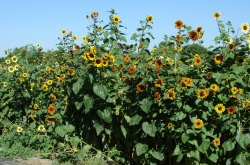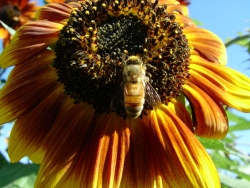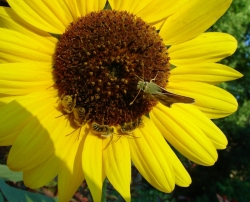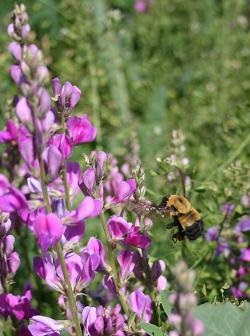
in Cache Valley
Image courtesy and Copyright Jim Cane
 Honey bee foraging at sunflower
Honey bee foraging at sunflower
Image courtesy and Copyright Jim Cane
 Male Melissodes bees and a skipper
Male Melissodes bees and a skipper
butterfly sleeping on a sunflower at dusk
Image Courtesy and Copyright Jim Cane
Now, in late summer, the sunny golden blooms of sunflowers adorn gardens, roadsides and wild places across much of the United States. Utah is home to five sunflower species, four of them annuals. You are most likely to see Helianthus annuus, the aptly named “common sunflower”. Early domestication of common sunflower by Plains Indians led to the major oilseed crop that the world enjoys today.
Humans are not the only species seated at the sunflower dining table, however. The grub of one specialist weevil bores in sunflower stalks; as do larvae of 2 long-horned beetles. Another weevil hollows out the seeds. A third decapitates the flowerhead before ovipositing. One moth’s caterpillar gnaws the roots; several cutworm species topple seedling sunflowers, and several more kinds of butterfly caterpillars skeletonize sunflower leaves. In your garden, though, sunflowers generally escape pestilence. Chickadees and both American and Lesser Goldfinches cling to the ripe seed heads to pluck out the nutritious seeds. Listen for the plaintive call of the Lesser Goldfinch which is very distinctive.
[Lesser Goldfinch, Audio recording courtesy Kevin Colver, https://wildstore.wildsanctuary.com/collections/special-collections: Songbirds of the Southwest Canyon Country]
All those sunflower seeds are the direct result of pollination by bees. In the American West, more than 200 species of native bees visit sunflowers for nectar or pollen, a remarkably large fauna for any flower. None is more charming than the male of the bee genus Melissodes. They are discernible by their extra long antennae. Melissodes males dart among sunflowers all day long, seeking willing mates. Come sunset, the males bed down on the flower heads to snooze. They become drowsy enough to pet with your fingertip, and being males, have no sting. So if you have sunflowers at hand, chances are you have Melissodes bees around too. Look over your sunflowers this evening, and you may be lucky enough to find these dozing bachelor bees with their extra long antennae.
This is Linda Kervin for Bridgerland Audubon Society.
Credits:
Audio: Courtesy Kevin J. Colver, 7loons.com and On Amazon.com
Photos: Courtesy and Copyright Jim Cane
Text: Jim Cane, Bridgerland Audubon Society
Additional Reading:
LeBuhn, Gretchen, Greenleaf, Sarah, Cohen, David, The Great Sunflower Project, Department of Biology, San Francisco State University, https://www.greatsunflower.org/
Charlet, Larry D., Brewer, Gary J., Sunflower Insect Pest Management in North America, Radcliff’s IPM World Textbook, University of Minnesota, https://ipmworld.umn.edu/chapters/charlet2.htm


